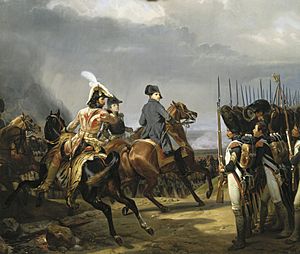Battle of Jena-Auerstadt facts for kids
Quick facts for kids Battle of Jena–Auerstedt |
|||||||||
|---|---|---|---|---|---|---|---|---|---|
| Part of the War of the Fourth Coalition | |||||||||
 Napoleon reviewing the Imperial Guard, by Horace Vernet. |
|||||||||
|
|||||||||
| Belligerents | |||||||||
| Commanders and leaders | |||||||||
| Strength | |||||||||
| 197,000 150,000 (Jena); 47,000 (Auerstedt) |
120,500 60,000 (Jena); 60,500 (Auerstedt) |
||||||||
| Casualties and losses | |||||||||
| 14,920 dead and wounded 7,500 (Jena); 7,420 dead and wounded (Auerstedt) |
38,000 dead, wounded and captured 25,000 (Jena); 13,000 (Auerstedt) |
||||||||
The Battle of Jena–Auerstedt was a very important battle fought on October 14, 1806. It was a major part of the War of the Fourth Coalition. This battle took place between the armies of France, led by Napoleon, and the armies of Prussia. The French won a huge victory, which led to Napoleon taking control of Prussia.
Contents
Why the Battle Happened
In 1806, several powerful countries formed an alliance called the Fourth Coalition. This group included Great Britain, Sweden, Russia, and Prussia. They joined forces against Napoleon and France.
Napoleon decided to invade Prussia in the fall of that year. The Prussian army at Jena–Auerstedt was commanded by Charles William Ferdinand, Duke of Brunswick-Wolfenbüttel. He was 71 years old, and many of his main commanders were also in their 60s.
The Prussian army was still using old fighting methods. These methods were from the time of Frederick II of Prussia, who had died many years before. A big problem for the Prussians was their poor organization. Their different army groups did not talk to each other well.
On the other hand, Napoleon's army was very experienced. They had excellent leaders and had won many battles. The two armies finally met on October 14, 1806, near the towns of Jena and Auerstedt.
The Armies Involved
The Prussian army was divided into three main groups:
- About 75,000 soldiers led by the Duke of Brunswick.
- About 42,000 soldiers led by the Prince of Hohenlohe.
- About 15,000 soldiers led by Ernst von Rüchel.
The French army at Jena had about 150,000 soldiers in total. These included:
- Nicolas Jean de Dieu Soult's IV Corps.
- Jean Lannes' V Corps.
- Michel Ney's VI Corps.
- Pierre Augereau's VII Corps.
- Joachim Murat's cavalry (horse soldiers).
At Auerstedt, the French forces were made up of Louis Nicolas Davout's III Corps and Jean-Baptiste Bernadotte's 1 Corps.
The Battle of Jena
The French army started by trying to attack the sides of the Prussian army. While they were getting into position, Marshal Ney attacked without waiting for orders. At first, Ney's attack went well. But soon, his soldiers were surrounded and under heavy attack from the Prussians.
Napoleon quickly sent Marshal Lannes to help Ney. This left the middle of the French army a bit weak. So, Napoleon brought in his best soldiers, the Imperial Guard, to hold the center. This rescue worked, and Ney's soldiers were able to pull back safely. The Prussians did not use this chance to attack the weak French center.
Around 1 P.M., Napoleon decided it was time to make his big move. The French soldiers on the sides pushed hard against the Prussian sides. At the same time, the French in the middle attacked the Prussian center. The attacks on the sides worked perfectly, and the Prussian soldiers started to run away. They lost about 10,000 soldiers, 15,000 were captured, and 150 cannons were lost.
The Battle of Auerstedt
While the battle was raging at Jena, Marshal Davout's III Corps was fighting at a small village called Auerstedt. The Duke of Brunswick attacked Davout's smaller force with 60,000 of his own soldiers.
However, the Prussians attacked in small groups, one after another. This allowed the French to hold them off for six hours. During the fighting, the Duke of Brunswick was badly wounded and later died. With their commander gone, the Prussian army became disorganized. The French then destroyed the last Prussian attack and won the battle.
What Happened Next
After the battles, Napoleon was not fully aware of everything that had happened. He thought he had defeated the entire Prussian army. But in reality, he had only beaten parts of it. There was still a large Prussian army of about 100,000 soldiers who had not been in the battles.
Napoleon even doubted Marshal Davout's victory at Auerstedt. He famously said, "tell your marshal he is seeing double," hinting that Davout's bad eyesight made him think he had fought a larger force. Despite this, Davout was later given the title Duke of Auerstedt for his bravery.
The French army then marched into Berlin, the capital of Prussia. Soon after, France and Prussia signed peace agreements. These battles showed Napoleon's military genius and greatly changed the map of Europe.
Images for kids
-
Marshal Joachim Murat, a famous French cavalry leader, leads a charge during the battle.
-
Prussian wounded and soldiers leaving the battle by Richard Knötel. The Duke of Brunswick is shown wounded in the painting.
-
French troops entering Berlin.
-
The Pont d'Iéna bridge in Paris was built to remember the Battle of Jena.
See also
 In Spanish: Batalla de Jena para niños
In Spanish: Batalla de Jena para niños











